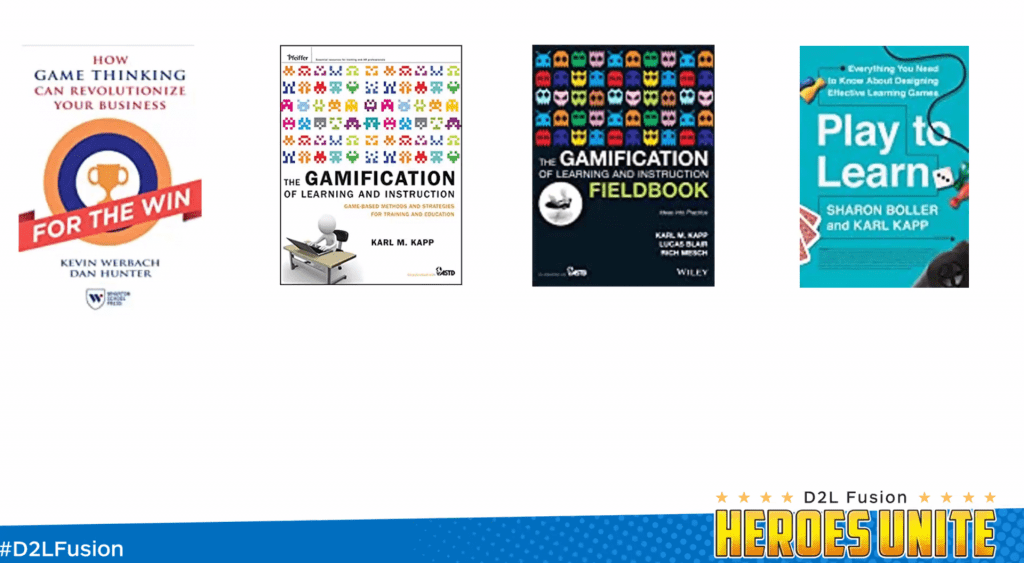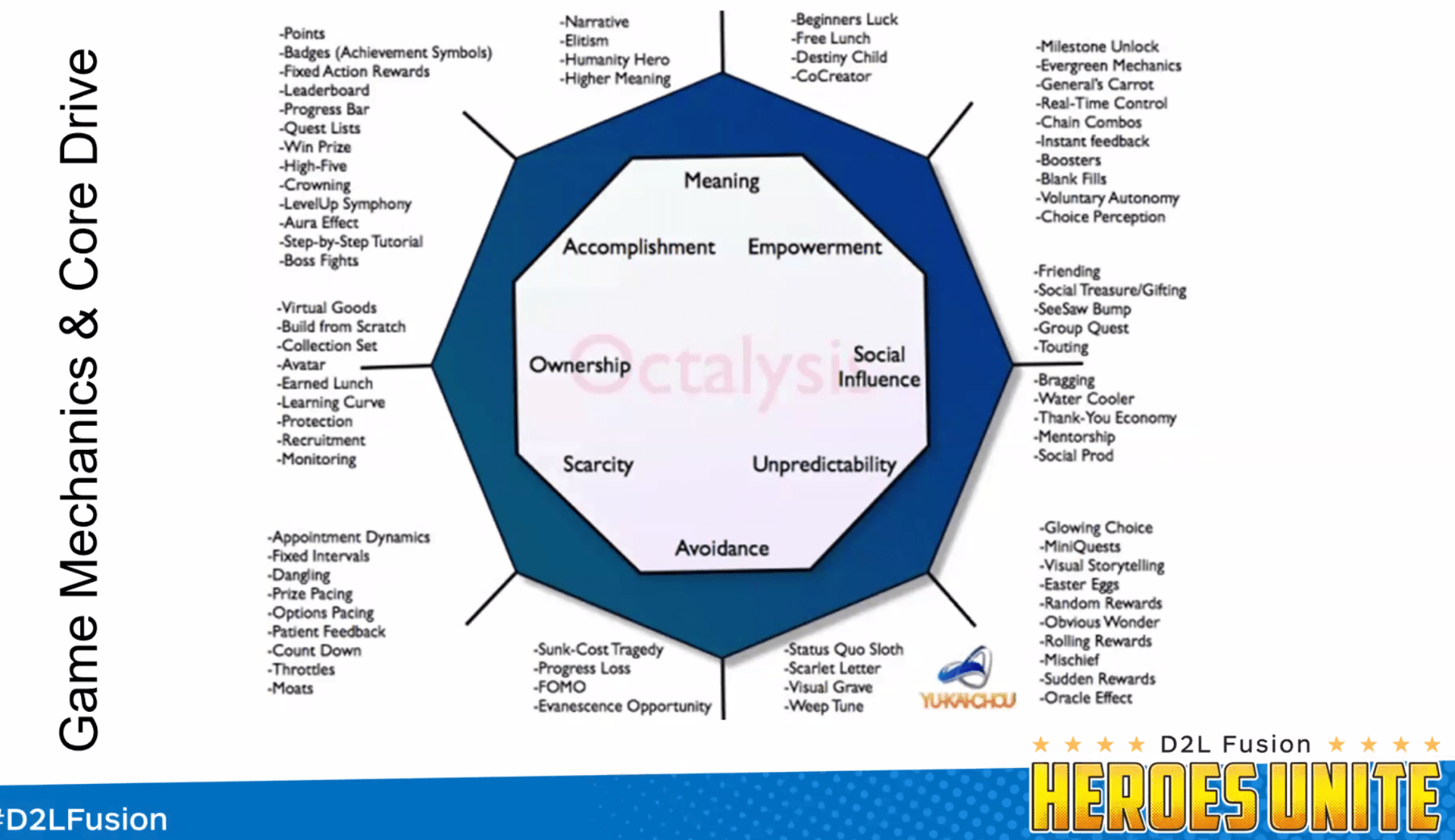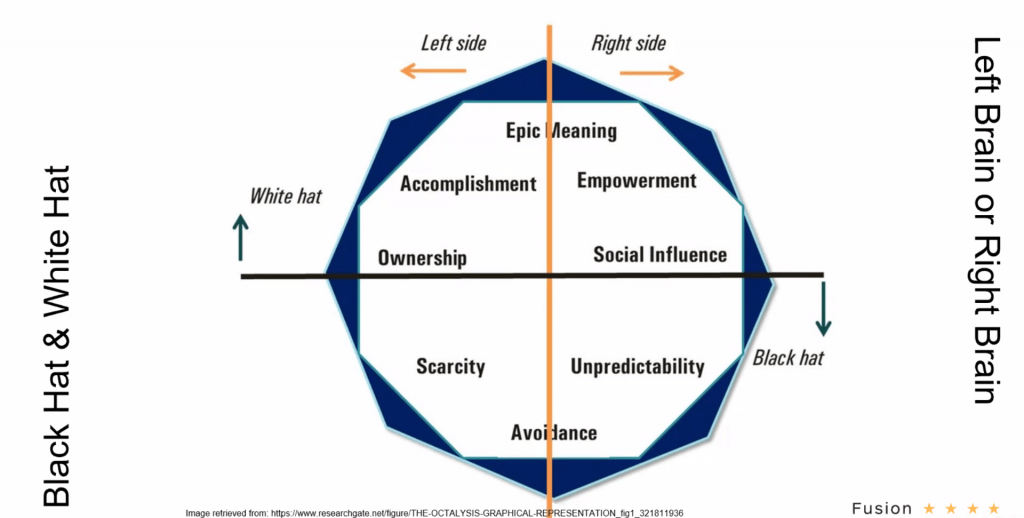Laubersheimer, J., Ryan, D., & Champaign, J. (2016). InfoSkills2Go: Using Badges and Gamification to Teach Information Literacy Skills and Concepts to College-Bound High School Students. Journal of Library Administration, 56(8), 924.
https://www.academia.edu/21782837/InfoSkills2Go_Using_Badges_and_Gamification_to_Teach_Information_Literacy_Skills_and_Concepts_to_College_Bound_High_School_Students?email_work_card=title
From online trivia and virtual board games to complex first-person perspective video games and in-person scavenger hunts, libraries are creating games for a variety of purposes, including orientations and instruction (Broussard,2012; Mallon, 2013; Smith & Baker, 2011).
Although the line between gaming and gamification can be blurry, most scholars recognize differences. Games are interactive, involvechallenge, risk, and reward, and have rules and a goal (Pivec, Dziabenko, &Schinnerl, 2003; Becker, 2013). Gamification, on the other hand, utilizes spe-cific gaming elements, often interactivity and rewards, to make an ordinary task more engaging (Prince, 2013). The gamification layer is not the focus of an endeavor, but rather can add enjoyment and a sense of competition toa task.
Battista (2014) argues that well-executed badges could represent an authentic assessment tool, because they often require the student to tangibly demonstrate a skill, competency, or learning outcome.
Use of the badges helped the team organize the Web site and provided a hierarchy to follow once the steps for earning each badge were created.Each badge consists of three to six tasks. A task can be a tutorial, a video, a game, or a short reading assignment on a given topic. An assessment is given for each task
The fourth and final platform the group considered was BadgeOS fromLearningTimes. BadgeOS requires a WordPress installation BadgeOS was designed to work with Credly (https://credly.com/) and Mozilla Open Badges (http://openbadges.org/) as standard features.
LearnDash was the most useful plugin for the project beyond BadgeOS. Available for a reasonable fee, LearnDash adds tools and features that give WordPress the ability to be used as a complete learning management system(LMS).
Available for free under the GNU Public License, BuddyPress(https://buddypress.org/) is another plugin that was capable of integrating with BadgeOS as an extension. The advantage of BuddyPress for the project group was the addition of social media components and functionality to the project Web site.
Go-daddy.com offered comprehensive technical support, easy application instal-lation, and competitively priced hosting packages. A 3-year hosting agree-ment was purchased that included domain registration, unlimited storageand unlimited bandwidth.
compare to
practical application of D2L Brightspace badges for a chemistry course at SCSU
https://blog.stcloudstate.edu/ims/2019/11/06/mastery-of-library-instruction-badge/
standard library instruction
Hung, A. C. Y. (2018). Gamification as Design Thinking. International Journal of Teaching and Learning in Higher Education, 30(3), 1812–9129.
By reflecting-in-action, the practitioner is able to gain metacognitive awareness and perceive his/her intuitions and biases, test hypotheses, and take on new perspectives. The approach of having students learn by designing their own games combines design thinking and game-based learning (Kafai, 1995, 2006; Li, Lemieuz, Vandermeiden, & Nathoo, 2013). Design thinking also supports new forms of literacies brought on by new media technologies as well as game-based learning.
It is likely that the effects of gamification cannot easily be measured satisfactorily through surveys of motivation, engagement, attendance, or grades because there are too many variables that could affect how students respond. Critics of gamification argue that it over
simplifies complex problems (Bogost, 2015; Robertson, 2010). However, both gamification and design thinking are approaches to problem-solving. With design thinking, gamification may be used in more meaningful ways because design thinking offers a different lens through which to conceptualize the problem.
4 Benefits of Gamification in the Online Classroom
1. Combining Learning and Gaming Develops Additional Skills
2. Gamification Dwarfs the Fear of Failure
3. Game-Based Learning Provides Short-Term Rewards
4. Gamifying the Learning Experience Promotes Collaboration and Healthy Competition
++++++++++++++
more on gamification in this IMS blog
https://blog.stcloudstate.edu/ims?s=gamification
Study: Gamification Techniques Can Improve Online Teaching
https://campustechnology.com/articles/2021/04/12/study-gamification-techniques-can-improve-online-teaching.aspx
A new study out of MIT‘s Sloan School of Management explores the use of ideas and tools from the gaming community to improve online teaching and student learning outcomes.
four key elements for maximizing student engagement in online learning:
- Narrative — a specific storyline or overarching theme. For instance, study co-author Brian Stevens, senior lecturer at the University of Tennessee‘s Haslam College of Business, created a video game theme for his statistics class, incorporating “Boss Battles,” “Speed Runs” and wacky characters to spice up his lectures.
- Continuous flow of action in sight and sound, even before class starts. For example, Lo uses a countdown timer and upbeat music on his course page about 30 minutes before the start of a synchronous lecture, to build anticipation for class. He also switches tasks and/or scenes every 15 minutes to help maintain students’ attention and interest levels.
- Opportunities for two-way communication. To help turn students from viewers into participants, Lo uses a combination of the “Raise Hand” function in Zoom, polls, breakout sessions, surveys and the chat window.
- High production quality. Lo built a home studio with various input devices, professional lighting, a green screen and more to create richer, more engaging presentations for students.
The full study, “The World of EdCraft: Challenges and Opportunities in Synchronous Online Teaching,” is openly available online
serious gamers and gamification experts on that panel. More here on the initiative: https://tinyurl.com/IABOL2021
+++++++++++++++++++
more on gamification in this IMS blog
https://blog.stcloudstate.edu/ims?s=gamification
https://www.masteroapp.com/blog/three-different-types-of-gamification-in-learning/

++++++++++++++
more on gamification in this IMS blog
https://blog.stcloudstate.edu/ims?s=gamification
Gamification Network: Exploring Gamification through the Octalysis Lens
Mary Nunaley
Karl Kapp The Gamification of Learning and Instruction
Kevin Werbach, Dan Hunter How Game Thinking Can Revolutionize Your Business
Yu-Kai Chou gamification design. Octalysis. https://www.gish.com/
8 core drives:
Meaning
Accomplishment
Empowerment
Ownership
Social Influence. social media, instagram influencers
Scarcity: scarcity with homework deadlines, coupons at the store
Unpredictability and curiosity. scavenger hunt in courses. careful when teaching.
Avoidance


Octalysis – the complete Gamification framework
Webinars
motivation

+++++++++++++++
https://yukaichou.com/octalysis-tool/
+++++++++++++++
https://island.octalysisprime.com/
+++++++++++++
https://yukaichou.com/
+++++++++++++
Home
++++++++++++++
++++++++++++
more on gamification in this IMS blog
https://blog.stcloudstate.edu/ims?s=gamification
Achievement Unlocked_ Understanding the Future of Gamification in Education.docx
https://www.academia.edu/38551388/Achievement_Unlocked_Understanding_the_Future_of_Gamification_in_Education_docx
how gamification elements may be applied to a typical Science, Technology, Engineering and Mathematics (STEM) class to support engagement, discuss the limitations of gamification in the classroom and finally provide a perspective on the future of gamification in education
Osello, A., Rapetti, N., Del Guidice, M., Guinea, A. M., Ronzino, A., Ugliotti, F., & Migliarino, L. (2015). AUGMENTED REALITY AND GAMIFICATION APPROACH WITHIN THE DIMMER PROJECT.
INTED2015 Proceedings, 2707–2714.
https://www.academia.edu/29582198/AUGMENTED_REALITY_AND_GAMIFICATION_APPROACH_WITHIN_THE_DIMMER_PROJECT
++++++++++++++++++
more on AR in this IMS blog
https://blog.stcloudstate.edu/ims?s=augmented+reality
more on gamification in this IMS blog
https://blog.stcloudstate.edu/ims?s=gamification



